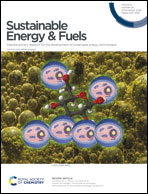Complementary effects of functionalization, vacancy defects and strain engineering in activating the basal plane of monolayer FePS3 for HER†
Abstract
In the quest for inexpensive electrocatalytic materials for hydrogen evolution reaction (HER), transition metal based ternary layered tri-chalcogenides are one of the most promising candidates. Most efficient catalyst materials in this class are found to have active sites at their edges, and no systematic efforts have been reported to activate their basal planes. Here we report a three-pronged strategy to activate the basal plane of one candidate material, FePS3. First principles calculations are used to study the effects of functionalization via non-metal substitutional doping, vacancy creation and strain engineering in activating basal plane sites on a monolayer FePS3 towards HER. It is found that while in some cases dopants directly activate sites on the plane, in other cases the activity can be fine-tuned towards an optimum level by the complementary effects of doping and strain engineering. Finally, in addition to functionalization and strain engineering, we have also explored how change in hydrogen concentration influences the HER catalytic efficiency by investigating low and high H+ concentration situations.



 Please wait while we load your content...
Please wait while we load your content...